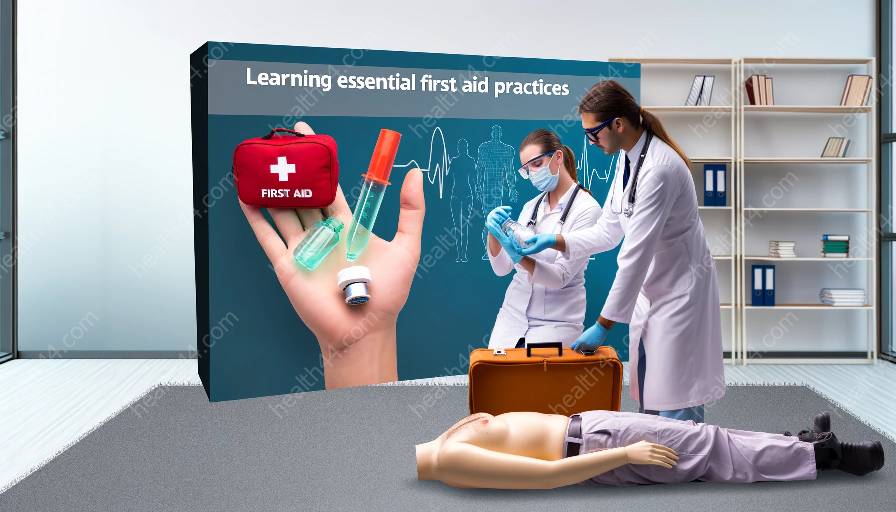Choking emergencies can be life-threatening situations that require quick and effective intervention. Understanding the causes, symptoms, and appropriate response to choking incidents is essential for anyone involved in first aid, health education, or medical training. This topic cluster explores the nature of choking emergencies, the application of the Heimlich maneuver, and its significance in promoting public health and safety.
The Importance of First Aid Training
First aid is a crucial skillset that equips individuals with the knowledge and techniques to provide immediate assistance to those in distress. Choking emergencies represent one of the most common types of incidents requiring prompt intervention, making it imperative for first aid providers to be well-versed in the appropriate response protocols, including the Heimlich maneuver.
Understanding Choking Emergencies
Choking occurs when a person's airway is obstructed, leading to difficulty in breathing. Common causes of choking include swallowing large pieces of food, foreign objects becoming lodged in the throat, or medical conditions that affect the throat muscles or nerves. Signs of choking can include difficulty speaking, coughing, and clutching at the throat. In severe cases, the person may be unable to speak or breathe, which necessitates immediate action.
Recognizing Choking Symptoms
It is vital to recognize the symptoms of choking to effectively respond to the emergency. People experiencing choking may exhibit signs such as panic, inability to speak, or a loss of consciousness. In some cases, the individual may gesture to their throat to signal that they are in distress. Prompt recognition of these signs is crucial for initiating the appropriate assistance without delay.
Introduction to the Heimlich Maneuver
The Heimlich maneuver, named after the American physician Dr. Henry Heimlich, is a first aid technique used to dislodge an obstruction from a person's airway. This technique is designed to create a forceful upward thrust in the abdomen, increasing pressure in the chest cavity to expel the blockage from the airway. The Heimlich maneuver is an integral component of first aid protocols for choking emergencies and is widely taught in health education and medical training programs.
Applying the Heimlich Maneuver
When performing the Heimlich maneuver, it is essential to ensure the safety and comfort of the choking individual. The following steps outline the procedure:
- Stand behind the person, wrapping your arms around their waist.
- Make a fist with one hand and place the thumb side below the person's rib cage and just above their navel.
- Grasp the fist with your other hand and give quick, upward thrusts into the abdomen.
- Continue with thrusts until the object is dislodged and the person can breathe or until emergency medical assistance arrives.
It is crucial to perform the Heimlich maneuver with caution and precision, as improper execution can lead to further injury or complications in the choking individual.
Integration with Health Education & Medical Training
Education and training play a pivotal role in promoting awareness and preparedness for choking emergencies. Health education programs and medical training courses frequently incorporate comprehensive instruction on first aid techniques, including the Heimlich maneuver, to ensure that healthcare professionals and the general public are equipped to respond effectively in emergency situations.
Simulation and Hands-On Practice
Medical training often involves simulation-based learning and hands-on practice to familiarize individuals with the proper execution of the Heimlich maneuver. Through practical scenarios and skill drills, participants develop the confidence and proficiency required to intervene in real-life choking emergencies, emphasizing the importance of ongoing training and skill maintenance.
Public Health Implications
Choking emergencies can occur in a variety of settings, including homes, public spaces, and workplaces. Public health initiatives that promote first aid education and training, including the proper administration of the Heimlich maneuver, contribute to a safer and more prepared community. By empowering individuals with the knowledge and skills to respond to choking incidents, public health campaigns can significantly reduce the potential risks associated with airway obstructions.
Conclusion
Choking emergencies demand timely and effective intervention to prevent severe consequences. The Heimlich maneuver stands as a fundamental first aid technique that plays a critical role in addressing choking incidents. By integrating this knowledge into first aid, health education, and medical training, individuals can become proficient in recognizing and responding to choking emergencies, ultimately enhancing public health outcomes and promoting a culture of safety and preparedness.



